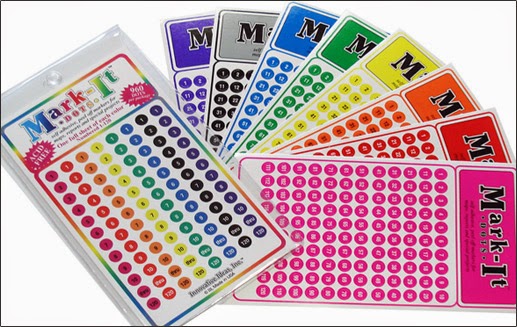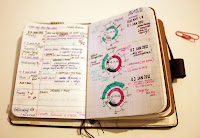Finding a planner is the first step to creating your perfect planning system. However, this discovery of your “perfect planner” is not the end. Now, you must create a method of planning that is both effective and easy for you to use. A planner is no help if you do not use it. Every person is different and has a unique approach on organizing their planner but one thing that many use is color coding.
Some may avoid color coding because it is “too much” and others (such as myself) have every color of the rainbow in pen form. Whether you are highlighter crazy or feel better when everything is in black, here are a few different methods and styles of color coding.
Styles of Color Coding:
Color by Class
This is a very popular method of color coding for any type of student, but can be also applied to different work commitments or different types of anything going on in your life. The jist of it is that you pick a color for every class and use that color to write down any events, assignments, tests, quizzes, and everything else that pertains to that color.
This method is a good visual when just glancing at your planner and applying some time management skills. Now you know that you need to set a lot of time aside to do math or perhaps only need a half hour for an English reading. It may require many different colors but it is a method that many swear by.
Another version of this method if you are not a student or perhaps don’t need more than one color for school, is to color code each area of your life. For example, one color for everything that is personal, another for everything related to school, and/or another for work,etc.
Color by Person
Perhaps you aren’t a student, maybe you are the planner person of a busy family and you need to keep everybodys’ work schedules, dance lessons, and soccer practices straight. Having a different color for every single type of event isn’t very plausible but having a color for each family member is a bit more manageable.
This is a great option if you are using a non-planner planning method, such as a white board, or if children are using this planning method as well. Every family member gets their own color and can reference said color when making plans.
Color by Priority
Color coding by priority can be good for people who don’t want a different color for every class or person but they need to know what to work on first. This method requires maybe three colors and can be applied very easily whether using pens or highlighters.
For this method, we would three different colors. Red for urgent, blue for important (needs to be done soon), and black for non-urgent tasks that need to be done but are not of high priority. If you rather everything be written in one color, you can pick different color highlighters and use the same concept.
There are probably other methods of color coding as well, and we encourage you to leave your suggestions in the comments for other readers! So, now that we’ve covered different styles, all that is left is the few methods of color coding that we have compiled just for our lovely audience. We’ve tried to cover the masses, from people who don’t like a lot of color or too many pens all the way to the people who love when their planner looks like a rainbow threw up on it.
Methods of Color Coding
Writing Each Task in Different Colors
Obviously for color coding, multiple colors are necessary. The first method of color coding being one of the more obvious, is writing or highlighting each task in the color that pertains to said class/area of life.
Many people (such as myself) use this method and swear by it, The colorful to-do list is much less daunting to look at compared to a plain black list in my opinion. There are a few downfalls of this method however:
- You do need many colors and sometimes, there just aren’t enough for what you need (Especially with highlighters).
- One must find a way to carry all the highlighters or pens needed on a daily basis. Along with white-out or an eraser or whatever else you may need.
Using Post-It Notes
 This method can be great for people who may not have a traditional planning method or perhaps just have too many post-it notes (if that’s even possible). This method is basically assigning each colored post-it notes for each category of your life and writing everything within that category on the assigned post-it.
This method can be great for people who may not have a traditional planning method or perhaps just have too many post-it notes (if that’s even possible). This method is basically assigning each colored post-it notes for each category of your life and writing everything within that category on the assigned post-it.
This method can get a bit pricey and bulky but is one of the only methods that can be moved to basically anywhere. This can be great if you want to remember to grab a book, you can simply move the note from your planner to your bathroom mirror or your front door!
Using Stickers or Mark-It Dots
 For those who want to color code but do not want five million pens floating around in their bag, this method requires only ONE writing utensil and just a few extra sheets within your planner! Colored stickers or Mark-It Dots are nearly limitless in colors and take up much less space than other methods.
For those who want to color code but do not want five million pens floating around in their bag, this method requires only ONE writing utensil and just a few extra sheets within your planner! Colored stickers or Mark-It Dots are nearly limitless in colors and take up much less space than other methods.
Mark-It dots come in many different sizes, even as small as ⅛ inch and in many different colors. You can simply use these to mark your different categories and write all of your tasks in your preferred color. Now, where to find such an amazing thing? I believe many office supplies stores carry them, or perhaps your local Target, Walmart, or simular type of store. If you cannot find them in your location, there is always the lovely option of Amazon or other online sellers. However, with this method, you can basically use any stickers so long as they come in enough colors to fit to your needs.
I bet you never thought that you would read such a long post on color coding huh? This is probably only scratching the surface and we would love to hear about how you color code your planning system! Your methods, no matter how crazy or unorthodox they may be, could be just as perfect for somebody else and they don’t know it yet. We always love to hear about other’s ideas when it comes to planning and organizing of all kinds or requests for future posts. So until next time, keep planning PlannerPeople!
P.S Remember that we are just giving suggestions. If you try something and it isn't working, fret not and try something new. Don't settle for a planner system. You deserve to be a less stressed version of yourself and a planner can do that for you. :)









